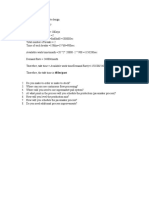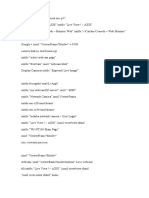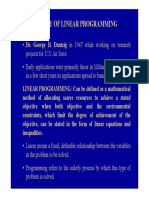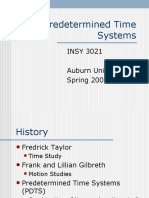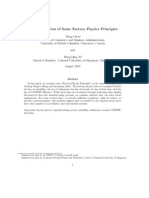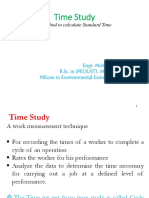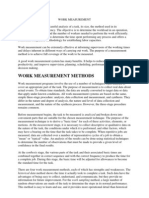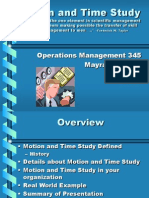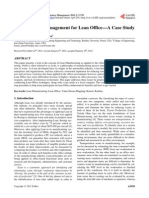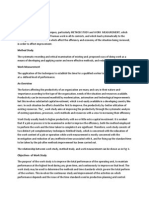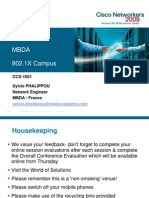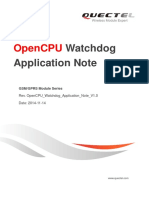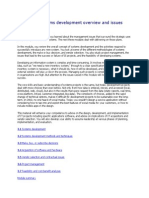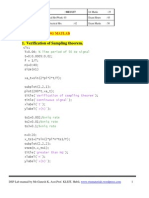Queuing Theory
Queuing Theory
Uploaded by
Arkhiem Von TussleCopyright:
Available Formats
Queuing Theory
Queuing Theory
Uploaded by
Arkhiem Von TussleOriginal Description:
Copyright
Available Formats
Share this document
Did you find this document useful?
Is this content inappropriate?
Copyright:
Available Formats
Queuing Theory
Queuing Theory
Uploaded by
Arkhiem Von TussleCopyright:
Available Formats
Queuing Theory and
Measurement of Effectiveness
Simulation & Modeling
Kardi Teknomo, PhD
Kardi Teknomo, PhD
Overview
Queuing Theory
Arrival distribution
Service time distribution
Kendal notation
Measurement of effectiveness
M/M/1
M/M/s
Queuing Optimization
Optional: Queue with Limits
Kardi Teknomo, PhD
Objectives
By the end of this lesson you should be able to
Compute Measurement of Effectiveness (MOE) of
simple queuing with multi channel
Find cost effective queuing channel
Kardi Teknomo, PhD
What is queuing theory?
Queue = waiting line
Q
Queuing
i theory
th
= the
th body
b d off knowledge
k
l d
dealing with waiting lines
Kardi Teknomo, PhD
Queuing Model
Kardi Teknomo, PhD
Queueing systems are pervasive
Banks
Traffic
Hospitals
Go e nment offices
Government
Supermarkets
R t
Restaurants
t
Documents in office
Files
Products queue for Machine
Kardi Teknomo, PhD
Queueing System
Input:
Arrival Rate & Distribution
Service rate & Distribution
Configuration
g
(e.g.
( g Parallel,, serial))
Waiting Capacity (Max queue length)
Population (finite or infinite)
Service Discipline
Output:
Measurement of Effectiveness (MOE) or operating
characteristics (performance measures)
Kardi Teknomo, PhD
Arrival Distribution
Most common type
Markovian (= Poisson Process)
Deterministic (e.g. constant or linear by time)
If the number of arrival in a given period of
time occurs randomlyy and independently
p
y from
other arrivals and follows a Poisson
distribution with mean customers/minute,
th th
then
the interarrival
i t
i l time
ti
(h d
(headway)
)
distribution follow an exponential probability
distribution with mean 1/ minutes
Kardi Teknomo, PhD
Poisson Probablity Distribution
Distribution of arrivals
Probability of x arrivals in a specific time
period:
P ( x) =
N ti
Notice:
PMF
x e
x!
, x = 0,1, 2,"
Kardi Teknomo, PhD
Practice-1: Poisson Distribution
Teknomos Burger has analyzed the data on
customer arrival & found that the disribution is
Poisson and the mean arrival rate is 45
customers/60 minutes. Compute
p
the probability
p
y
of x customer arrive during a 1 minute period
for x = 0, 1, 2, 3, 4, >=5
Kardi Teknomo, PhD
Answer Practice 1
= 45/60 minutes = 0.75 customers/minute
75/0! = e-0
0.75
75 = 0.4724
P(0)=(0 75)0e-00.75
P(0)=(0.75)
0 4724
P(1)=(0.75)1e-0.75/1! = 0.75 e-0.75 = 0.3543
Etc
Number of Arrivals
Probability
0.4724
0.3543
0.1329
0.0332
0.0062
5 or more
0 0010
0.0010
Kardi Teknomo, PhD
Service distribution
Most common
Markovian (Poisson Process)
Deterministic
General ((e.g.
g Unspecified/Normal
p
/
distribution))
Service rate = =average number of
customers that can be served p
per time period
p
(Poisson Dist.)
Average service time per customer = 1/ time
period (Exponential distributed)
Kardi Teknomo, PhD
Exponential distribution
Probability that the service time will be
less than or equal to a time length t is
P ( service time t ) = 1 e
e = 2.71828
Notice: CDF
Kardi Teknomo, PhD
Example (Practice 2)
Teknomos Burger has studied that order filling
process for single food server can process on
average 60 customers orders per hour.
Compute
p
the mean service rate per
p minute and
probaility that an order can be processed in
0.5 minutes or less,
1 minute or less,
2 minutes or less.
Kardi Teknomo, PhD
Answer Practice 2
Mean service rate = 60 customers/60
minutes = 1 customer/minute
P(service time 0.5 min) = 1 - e-1(0.5) = 1 - 0.6065 =
0.3935
P(service time 1.0 min) = 1 - e-1(1.0) = 1 - 0.3679 =
0.6321
1(2 0) = 1 - 0.1353
P(service time 2.0
2 0 min) = 1 - e-1(2.0)
0 1353 =
0.8647
Kardi Teknomo, PhD
Queueing Discipline
FIFO = First In First Out = FCFS = First come
first served
Others:
LIFO = Last In First Out
Balk = don
dontt join queue upon arrival
Renege = leave queue before being served
Jockey = swicth from one queue to another
Loop = join the same queue after served
Priority = certain type of customers will be served
fi t
first
Kardi Teknomo, PhD
Measurement of Effectiveness
U= Utilization factor = percentage of the time that all
servers are busyy
P0 = probability that there are no customers in the
system
Pn = probability
b bili that
h there
h
are n customers in
i the
h
system
Pw = probability that an arriving customer has to wait
for service
Kardi Teknomo, PhD
MOE (contd)
Wq = average time a customer spends in waiting line
waiting
g for service
W = average time a customer spends in the system (in
waiting line and being served)
Lq = average number
b off customer iin waiting
i i line
li for
f
service
L = average number of customer in the system (in
waiting line and being served)
Kardi Teknomo, PhD
Steady State & Transient
In the beginning the queuing system starts in
empty and idle condition then gradually go
through transient periods before the activities
reach steadyy state level
Queuing MOE formulas are derived from
Markov Chain to describe only steady state
(normal) operation.
Simulation will also show operation in both
transient and steady state condition
Kardi Teknomo, PhD
Kendall Notation
Kendal suggested a notation that is helpful in
classifying wide variety of different waiting line
A/B/k
A = prob.
prob distribution of arrivals
B = prob. distribution of service time
k = number of channels
Commonly used letter in position A or B are:
M = Poisson process (Poisson dist. for arrivals and
exponential dist. for service time)
D = Deterministic or constant
G=G
Generall prob.
b di
dist.
t With known
k
mean and
d
variance
Kardi Teknomo, PhD
MOE of M/M/1
Utilization factor
Prob. of n units in system
Prob. Empty system
U = = <1
Pn = n P0
P0 = 1 = 1
If utilization factor is larger to equal to 1
1, the waiting
line will continue to grow without limit
Kardi Teknomo, PhD
MOE of M/M/1 (contd)
1
Avg Waiting in Queue
Avg.
Wq = W
Avg. Waiting in System
1
W=
Avg. Queue Length
2
Lq = Wq =
( )
Avg. System Length
L = W = Lq +
Kardi Teknomo, PhD
Practice 3: M/M/1
Poisson Process (M/M/1)
= 0.75
0 75 customers/minute
= 1 customer/minute
Compute MOE of Teknomo
Teknomoss Burger:
U, P0, Lq, L, W, Wq
Pn where n = 0 to (7 or more)
Kardi Teknomo, PhD
Answer Practice 3
MOE of M/M/1: = 0.75, = 1
0.75
0 75
U == =
= 0.75 < 1 (OK )
1
2
0 752
0.75
Lq =
=
= 2.25 customers
( ) 1(1 0.75 )
L = Lq + = 2.25 + 0.75 = 3 customers
1
1
W=
=
= 4 minutes
i t
1 0.75
1
1
Wq = W = 4 = 3 minutes
1
Kardi Teknomo, PhD
Answer Practice 3 (contd)
0.75
= 0.25
P0 = 1 = 1 = 1
1
Pn = P0 = ( 0.75 ) 0.25
n
Numberofcustomers
0
1
2
3
4
5
6
7ormore
Probability
25.00%
18.75%
14.06%
10 55%
10.55%
7.91%
5.93%
4.45%
13.35%
Sum
25.00%
43.75%
57.81%
68 36%
68.36%
76.27%
82.20%
86.65%
100.00%
Kardi Teknomo, PhD
Effect of Changing units
Instead of using = 0.75
customers/minute and = 1
customer/minute, you might want to use
= 45 customers/hour and = 60
customers/hour
Will the MOEs change because we
change the units?
Kardi Teknomo, PhD
Effect of Changing units (contd)
Kardi Teknomo, PhD
Improving Waiting Line Operation
To reduce waiting time, we must focus
on service improvements:
1.
2
2.
Increase the mean sevice rate by making a
creative design change or by using new
technology
Add service channels so that more
customers can be served simultaneously
Kardi Teknomo, PhD
Practice 4: M/M/1
improved service
Teknomo Burger decide to employ an order
filler who will assist the order taker
taker. With this
design the management estimates the mean
service rate can increase from 60 customers
per hour into 75 customers per hour.
Compute the MOEs and compare the results to
practice 3
Kardi Teknomo, PhD
Answer Practice 4
MOE of M/M/1: = 0.75, = 1.25
0.75
0 75
U == =
= 0.60 < 1 (OK )
1.25
2
0 752
0.75
Lq =
=
= 0.9 customers
( ) 1.25 (1.25 0.75 )
L = Lq + = 0.90 + 0.60 = 1.5 customers
1
1
W=
=
= 2 minutes
i t
1.25 0.75
1
1
Wq = W = 2
= 1.2 minutes
1.25
Kardi Teknomo, PhD
Answer Practice 4 (contd)
0.75
P0 = 1 = 1 = 1
= 0.40
1.25
Pn = P0 = ( 0.60 ) 0.40
n
Numberofcustomers
0
1
2
3
4
5
6
7ormore
Probability
40.00%
24.00%
14.40%
8 64%
8.64%
5.18%
3.11%
1.87%
2.80%
Sum
40.00%
64.00%
78.40%
87 04%
87.04%
92.22%
95.33%
97.20%
100.00%
Kardi Teknomo, PhD
MOE of M/M/s
Utilization factor
U = 1s
s
+
P0 =
n =0 n ! s ! s
s 1
Prob. Empty system
P0 s +1
Avg. Queue Length
Lq =
Avg. System Length
L = Lq +
( s 1)!( s )
Kardi Teknomo, PhD
MOE of M/M/s (contd)
Avg. Waiting in Queue
Avg. Waiting in System
Prob. Of Waiting
Wq =
Lq
W = Wq +
s
Pw =
P0
s ! ( s )
n
P0
Prob. of n units in system
n!
Pn = n
P
s ! s n s 0
for n s
for n > s
Kardi Teknomo, PhD
Practice 5: multi servers
If the management of Teknomo burger want to
use 2nd order processing station so that
customers can bee served simultaneously, what
are the MOEs if
Arrival rate = 0.75 customers/min
Service rate = 1 customer/min
/
Kardi Teknomo, PhD
Answer practice-5
M/M/2: = 0.75, = 1.0
Build Spreadsheet
Compute P0 first
Then compute other MOEs
Kardi Teknomo, PhD
Economic Analysis of Queue
Mostly based on subjective evaluation of operating
characteristics
More scientific way is to use Total Cost model
TC = Cw L + Cs k
TC = total cost per time period
Cw =waiting cost per time period per each unit
L = average number of unit in the system
Cs = service cost per time period for each channel
k = number of channels
Kardi Teknomo, PhD
General shape of total cost model
Kardi Teknomo, PhD
Practice 6: economic analysis
Use spreadsheet of practice 5 to analyze total
cost model of Teknomos
Teknomo s burger given that
= 0.75, = 1.0
Server wages,
g , benefit and other direct costs is
P700/hour
Opportunty cost of losing a customer is P1000/hour
for customer waiting time
What is the most economical number of
channels?
Kardi Teknomo, PhD
Answer Practice 6
Input: Number of channel k=1,2,...,10
Obtain: Average system length, L
C
Compute
& chart:
h
Service
S i Cost
C
and
d Waiting
W i i Cost,
C
Total
T l cost
Optimum number of channels = 2
Kardi Teknomo, PhD
Queue with Limits
Kendal notation: A/B/k/C/D
C = Capacity
C
it off the
th queue (finite
(fi it total
t t l
seats or limited space)
D = Domain or population that may seek
service is finited (from which the arrivals
are derived)
Kardi Teknomo, PhD
MOE of M/M/s/K
U = 1s ( L Lq )
Utilization factor
Prob. Empty system P0 = 1 +
+
n =1 n ! s !
Avg. Queue Length
Lq =
P0 s
s !(1 )
(1
Avg System Length
Avg.
K s
( K s )
K s
n = s +1 s
K
(1 ) ) ,
s 1
L = nPn + Lq + s 1 Pn
n =0
n =0
s 1
ns
Kardi Teknomo, PhD
MOE of M/M/s/K (contd)
Lq
Avg. Waiting in Queue
Wq =
Avg. Waiting in System
L
W=
(1 PK )
Prob. of n units in system
n
P0
n!
n
Pn = n s P0
s !s
0
(1 PK )
for n = 1, 2," , s
for n = s + 1, s + 2," , K
for n > K
Kardi Teknomo, PhD
Practice 7
Compute MOE of queue with Poisson process
for both arrival rate and service rate with finite
queue K=5
Arrival rate = 5, service rate = 7
Number of server: 1, 2
Kardi Teknomo, PhD
MOE of M/M/s//N
Prob. Empty system
N !
N !
+
P0 =
ns
n =0 ( N n )!n !
N
n
!
s
!
s
(
)
n=s
s 1
Avg. Queue Length
N
Lq = ( n s ) Pn
n=s
Avg System Length
Avg.
s 1
L = nPn + Lq + s 1 Pn
n =0
n =0
s 1
Kardi Teknomo, PhD
MOE of M/M/s//N (contd)
Lq
Avg. Waiting in Queue
Wq =
Avg. Waiting in System
L
W=
( N L)
Prob. of n units in system
N ! n P0
( N n )!n !
N ! n P
0
Pn =
ns
!
!
N
n
s
s
(
)
( N L)
for 0 < n s
for s < n N
for n > N
Kardi Teknomo, PhD
Practice 8
Compute MOE of queue with Poisson process
for both arrival rate and service rate with finite
population N=10
Arrival rate = 0.01, service rate = 0.125
Number of server: 1, 2
You might also like
- Productivity and Reliability-Based Maintenance Management, Second EditionFrom EverandProductivity and Reliability-Based Maintenance Management, Second EditionNo ratings yet
- 8 Key Questions For Future State DesignDocument1 page8 Key Questions For Future State DesignSadeep RautNo ratings yet
- Source Selection Decision MemorandumDocument5 pagesSource Selection Decision MemorandumumeshaeroNo ratings yet
- FPRB User Manual Rev AHDocument76 pagesFPRB User Manual Rev AHSixto Manrique Miranda100% (2)
- MUDA (7 Waste)Document3 pagesMUDA (7 Waste)Shamshair Ali100% (1)
- CHAPTER 1: Productivity Measurement and Improvement: Learning ObjectivesDocument58 pagesCHAPTER 1: Productivity Measurement and Improvement: Learning ObjectivesJohn Mark HolgadoNo ratings yet
- Paper Airplane ActivityDocument4 pagesPaper Airplane ActivityRey AbarientosNo ratings yet
- Integrated Construction Information PDFDocument419 pagesIntegrated Construction Information PDFMartin Santos100% (3)
- EXAM 2013.07.08xlsDocument17 pagesEXAM 2013.07.08xlsmally4dNo ratings yet
- ANA Sales Training FrameworkDocument1 pageANA Sales Training FrameworkDemand Metric100% (2)
- Dorks CamerasDocument9 pagesDorks Camerasydrthr0% (1)
- Queuing (Waiting Line) ModelsDocument34 pagesQueuing (Waiting Line) ModelsNikhil KhobragadeNo ratings yet
- W12 - Queuing Theory 1Document52 pagesW12 - Queuing Theory 1Ronald WNo ratings yet
- RJS Penny Fab ModelDocument92 pagesRJS Penny Fab ModelRam Janm SinghNo ratings yet
- 2019 - 6 - Queueing ModelDocument52 pages2019 - 6 - Queueing Modelbisnis 5aNo ratings yet
- Tests For One Poisson MeanDocument9 pagesTests For One Poisson MeanJulyAntoNo ratings yet
- Linear Programming Graphical MethodDocument45 pagesLinear Programming Graphical Methodprasobh911No ratings yet
- 3021 - 07 Predetermined Time SystemsDocument37 pages3021 - 07 Predetermined Time Systemssunilkjain6105100% (1)
- Lot Sizing in MRPDocument49 pagesLot Sizing in MRPGauri Singh100% (1)
- EWMA Algorithm in Network PracticeDocument11 pagesEWMA Algorithm in Network PracticerzmaulNo ratings yet
- Operations Scheduling - SequencingDocument30 pagesOperations Scheduling - SequencingAjitesh AbhishekNo ratings yet
- Factory Physics PrinciplesDocument20 pagesFactory Physics Principlespramit04100% (1)
- Design of Goods and ServicesDocument10 pagesDesign of Goods and ServicesPoy GuintoNo ratings yet
- ASQ GSQ Training CompetenciesDocument3 pagesASQ GSQ Training Competenciesmseymour91No ratings yet
- S2-16-AAOC ZC111-L1 To L10Document327 pagesS2-16-AAOC ZC111-L1 To L10Abhi Ram MNo ratings yet
- Time Studies TrainingDocument28 pagesTime Studies TrainingAhmed AliNo ratings yet
- Control Volume Analysis Using EnergyDocument40 pagesControl Volume Analysis Using EnergyOmar FarukNo ratings yet
- Principles of Motion EconomyDocument63 pagesPrinciples of Motion EconomyAli ArsalanNo ratings yet
- Queuing TheoryDocument25 pagesQueuing Theoryrr9999100% (6)
- Queuing Theory EditedDocument19 pagesQueuing Theory EditedTrish Bustamante100% (2)
- Activity ChartsDocument23 pagesActivity ChartsKübra AkNo ratings yet
- Ch5 Summary and Exercises Student v3Document41 pagesCh5 Summary and Exercises Student v3Ahmet AydemirNo ratings yet
- Lean in Service Industry by MG. Kanakana (Corresponding Author)Document10 pagesLean in Service Industry by MG. Kanakana (Corresponding Author)Kun HarjiyantoNo ratings yet
- Work MeasurementDocument5 pagesWork MeasurementManohari RdNo ratings yet
- Assignment 1Document7 pagesAssignment 1Ann Coleen KayNo ratings yet
- Lecture CombinedDocument1,291 pagesLecture CombinedgeorgeNo ratings yet
- Ch2-Direct Time StudyDocument38 pagesCh2-Direct Time StudyHazim RahmanNo ratings yet
- Lecture 1 Motion and Time StudyDocument24 pagesLecture 1 Motion and Time Studyzakirno19248No ratings yet
- 001 Introduction Integral CalculusDocument36 pages001 Introduction Integral CalculusAj EstradaNo ratings yet
- Peat Example Peat NetworkDocument18 pagesPeat Example Peat Networklimulsa78No ratings yet
- Die Attach Dispensing MethodsDocument3 pagesDie Attach Dispensing Methodsquinn akaneNo ratings yet
- Week 5 Intro Time Study - Apr 3Document57 pagesWeek 5 Intro Time Study - Apr 3Aysenur ErdoganNo ratings yet
- GL3 e Chap 10Document19 pagesGL3 e Chap 10Aston Rahul PintoNo ratings yet
- SPC Quiz Mar 12Document1 pageSPC Quiz Mar 12Kathlene JaoNo ratings yet
- Dr. Mohamed Ben Daya Professor of Industrial Engineering & Operations ResearchDocument52 pagesDr. Mohamed Ben Daya Professor of Industrial Engineering & Operations ResearchParmjeetkumar YadavNo ratings yet
- An Instrument For Assessing Lean Service AdoptionDocument35 pagesAn Instrument For Assessing Lean Service AdoptionRaider622No ratings yet
- Operational Excellence FAQsDocument3 pagesOperational Excellence FAQsNaresh DeshpandeNo ratings yet
- Synchronous Manufacturing and The Theory of ConstraintsDocument21 pagesSynchronous Manufacturing and The Theory of ConstraintsSwaroop Ranjan BagharNo ratings yet
- Quality Costing Measurement & Productivity: By: - Hakeem-Ur-Rehman Ibit-PuDocument28 pagesQuality Costing Measurement & Productivity: By: - Hakeem-Ur-Rehman Ibit-PuBren DungcaNo ratings yet
- Productivity Class Practice Problems OM July 2019Document17 pagesProductivity Class Practice Problems OM July 2019Vinodshankar BhatNo ratings yet
- Lot Sizing PDFDocument30 pagesLot Sizing PDFSyeda SidraNo ratings yet
- Predetermined Time StudyDocument5 pagesPredetermined Time StudyJerome BayocbocNo ratings yet
- Article On Effective Operational ExcellenceDocument4 pagesArticle On Effective Operational Excellencealaissa cagubcobNo ratings yet
- QueuingDocument32 pagesQueuingSasana SanNo ratings yet
- 4-Chapter07 Factory PhysicsDocument93 pages4-Chapter07 Factory PhysicsDiscord YtNo ratings yet
- VSM Lean Office-A Case StudyDocument13 pagesVSM Lean Office-A Case StudySilviaNo ratings yet
- Power and Sample SizeDocument88 pagesPower and Sample SizejoannaorlovaNo ratings yet
- Notes in Method StudyDocument3 pagesNotes in Method StudyKathrine Kate CadiangNo ratings yet
- Standardised Work: F. Taylor 1900 S 1970 S 1990 'SDocument22 pagesStandardised Work: F. Taylor 1900 S 1970 S 1990 'SJanaNo ratings yet
- 2013-4-16 - P Using Lean Manufacturing Techniques To Improve Production Efficiency in The Ready Wear Industry and A Case Study PDocument7 pages2013-4-16 - P Using Lean Manufacturing Techniques To Improve Production Efficiency in The Ready Wear Industry and A Case Study Phemlata2014No ratings yet
- QUALITY CIRCLE PPT - Alvin DeliroDocument12 pagesQUALITY CIRCLE PPT - Alvin DeliroAlvin DeliroNo ratings yet
- Lecture 1 Introduction To ErgonomicsDocument23 pagesLecture 1 Introduction To ErgonomicsJan GuarnesNo ratings yet
- Final Exam Module NotesDocument7 pagesFinal Exam Module Noteslauren.barthenheierNo ratings yet
- Supplement D: Waiting Line ModelsDocument33 pagesSupplement D: Waiting Line ModelsSabir AliNo ratings yet
- Wa0014.Document19 pagesWa0014.sahooaiswarika2No ratings yet
- Cyberark Research TechniquesDocument4 pagesCyberark Research TechniquesSohitNo ratings yet
- SeleniumQ A28Jan PDFDocument120 pagesSeleniumQ A28Jan PDFparagvaruNo ratings yet
- Manage Task 3Document5 pagesManage Task 3Umar HassanNo ratings yet
- Che 530 Industrial Waste Management and Control: Chemical and Food Engineering DepartmentDocument3 pagesChe 530 Industrial Waste Management and Control: Chemical and Food Engineering DepartmentDK?No ratings yet
- Week NumberDocument2 pagesWeek NumbernekulaynekulayNo ratings yet
- Case Study: Mbda 802.1X Campus: CCS-1001 Sylvie Phalippou Network Engineer MBDA / FranceDocument30 pagesCase Study: Mbda 802.1X Campus: CCS-1001 Sylvie Phalippou Network Engineer MBDA / Francekds20850No ratings yet
- README GDB tdm64Document3 pagesREADME GDB tdm64dewaNo ratings yet
- Title PagesDocument8 pagesTitle PagesOmkar ShettyNo ratings yet
- GpsGate Server Inst Admin Guide 2.2Document16 pagesGpsGate Server Inst Admin Guide 2.2Genebaldo Avellar NetoNo ratings yet
- 07 Chapter 1Document43 pages07 Chapter 1Shourav RashedNo ratings yet
- Quectel OpenCPU Watchdog Application Note V1.0Document18 pagesQuectel OpenCPU Watchdog Application Note V1.0AdimaroNo ratings yet
- What Is Procurement ManagementDocument30 pagesWhat Is Procurement Managementcompiler&automataNo ratings yet
- Practical Exercise 2014Document3 pagesPractical Exercise 2014Dilshan JayasuriyaNo ratings yet
- Snap To Sell, Chat To Buy For FREE On The Carousell MarketplaceDocument54 pagesSnap To Sell, Chat To Buy For FREE On The Carousell MarketplaceAnonymous mFCE1fNo ratings yet
- Module 03Document48 pagesModule 03CGASTUFFNo ratings yet
- Entity Storage The D8 WayDocument39 pagesEntity Storage The D8 WaymikshaNo ratings yet
- Nse7 Efw-6.2Document10 pagesNse7 Efw-6.2Enrique Morales Cervantes100% (1)
- NCR AsofJune2018Document130 pagesNCR AsofJune2018Cyron BastianNo ratings yet
- SOP DoconDocument38 pagesSOP DoconAcep GunawanNo ratings yet
- Machine LearningDocument36 pagesMachine LearningAnonymous 2JrAgTuP1100% (1)
- Course Outline Itec301Document9 pagesCourse Outline Itec301Jawad TurkNo ratings yet
- VTU DSP Lab Manual 5th Sem E C Matlab Programs and CCS Studio ProgramsDocument35 pagesVTU DSP Lab Manual 5th Sem E C Matlab Programs and CCS Studio ProgramsSundaram NatarajanNo ratings yet
- 10 Commandments of Computer EthicsDocument3 pages10 Commandments of Computer EthicsVhia Cheilo NavasNo ratings yet
- Making PyObject - HEAD Conform To Standard CDocument5 pagesMaking PyObject - HEAD Conform To Standard Cmeknes_caftNo ratings yet
- Robot Tees+Hull A4Document6 pagesRobot Tees+Hull A4skheoNo ratings yet

